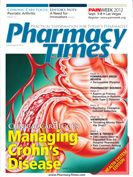Publication
Article
Pharmacy Practice in Focus: Health Systems
News and Trends Health Systems Edition
CMS Opens Doors to Expanded Role for Hospital Pharmacists
Due to a change in policy by the Centers for Medicare & Medicaid Services (CMS) that went into effect on July 16, 2012, pharmacists working in hospitals that participate in Medicaid and Medicare now have the go-ahead to perform all functions allowed by their states. This change in policy, as reported in an article on the website of the American Society of Health-System Pharmacists, does not make hospital pharmacists eligible for reimbursement by Medicare for clinical services, which would require changes to the laws governing the program.
The new policy could lead to a greater role for pharmacists in the medication reconciliation process. For instance, pharmacists could continue, discontinue, or substitute medications for a patient upon admission to the hospital and could also play a greater role in antimicrobial stewardship. The policy change also gives hospitals the option of allowing patients to self-administer certain medications, as long as measures are in place to safeguard the medications, gauge a patient’s ability to self-administer, and maintain documentation of medications that are self-administered. CMS is also allowing hospitals more room to apply standing orders for medications.
Pain Common Among Hospitalized Kids
Pain is very common among hospitalized pediatric patients despite the focus in recent years on improved pain management, according to the results of a study published online on June 11, 2012, in Pain Management Nursing.
For the study, researchers prospectively gathered information on 199 patients with an average age of 9 years who were treated at Johns Hopkins University between 2007 and 2008. They found that 86% of participants experienced pain and 40% experienced moderate to severe pain. In addition, being female, 5 years or older, and Caucasian were all associated with higher than average pain scores. Females and Caucasians also used more opioids on average than did males or non-Caucasians, respectively.
Factors associated with sub-optimal dosing with pain medication included lack of documented physician pain assessment and a high prevalence of “asneeded” analgesic dosing. Just a third of patients who were prescribed opiods “as-needed” received them, suggesting that their analgesic needs may not have been properly met. As a result, the researchers advise that giving patients preemptive, around-theclock access to pain medication is preferable to providing it “as-needed.”






